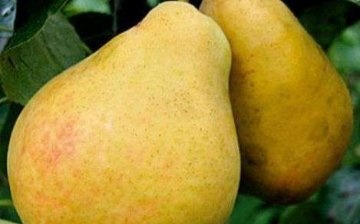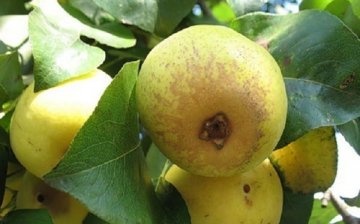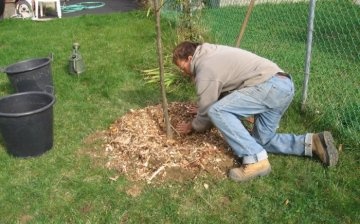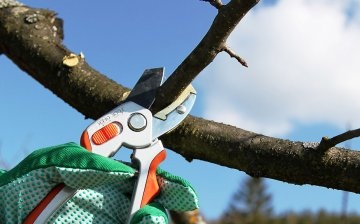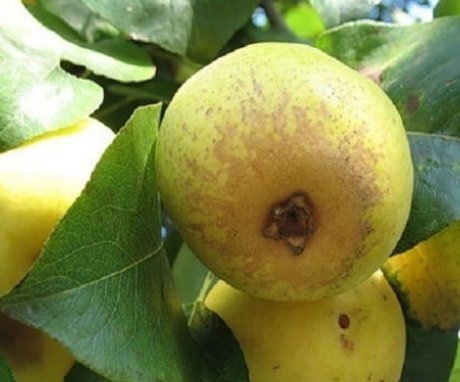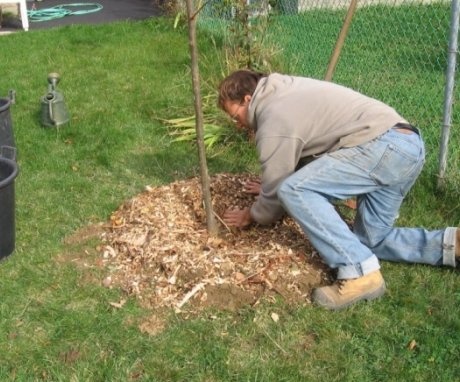Pear Limonka: description and agricultural technology
Growing fruit plants requires great attention to all stages of work. The gardener needs to study the plant, find the optimal conditions for it and guarantee constant care. By following the established rules and attention to detail, excellent results can be obtained. Below you can learn basic skills in handling a common pear variety - "lemon".
Content:
Description and benefits of the variety
This variety pears known for several centuries. It was bred by selection and has a close relationship with the Nizhegorodskaya pear variety. Gradually, the popularity of the pear has grown to a large size and today it can be found everywhere. Experts today continue to debate about the genetic origin of the fruit.
In the process of development, the tree reaches a height of 6 meters, which makes it possible to classify it as vigorous.
The width of the crown of the plant can also reach almost 6 meters. The shape of the crown is round and has a medium density. Branches usually branch off from the trunk at an acute angle, they are straight and brown in color. The emerging shoots are of medium size and curved. The buds are tied in small sizes and have a narrow cone shape. The foliage is medium-sized - the tree is largely "average". The fruits weigh about 100 grams and are formed in the shape of an "egg". The lemon yellow color was the main reason for the name of the whole variety.
From the merits of pear lemon, gardeners highlight the following points:
- Resistant to cold weather and freezing temperatures. The plant can easily endure even a harsh winter.
- The fruits are approximately the same size.
- The plant is resistant to various diseases.
- Pest resistance.
- High endurance in general.
- Productivity is usually at the same level.
- Storing the harvested fruits for a week does not lead to negative consequences.
Boarding rules and dates
Despite the fact that the Limonka variety is not at all whimsical to growing conditions, the gardener should strive to provide the plant with an optimal growing environment. This reduces the risk of negative moments in the development of the plant and contributes to the collection of a good harvest. The soil must be prepared in advance. To do this, it is recommended to loosen it, which contributes to the free access of oxygen to root system.
The pear can be planted both in spring and autumn.
A recess is prepared in the soil into which the seedling is placed. The root system is straightened approximately in a circle. After placing the seedling, it is sprinkled with soil, which is mixed in advance with the selected mineral fertilizers... After planting is complete, water the soil abundantly with several buckets of water. The seedling must be tied to a specially installed peg. Do not overtighten a plant that is not yet formed, so as not to impede sap flow.
It is important to choose the best option at the stage of choosing a seedling. To do this, you need to follow several rules:
- Buy seedlings in specialty stores that professionally grow plants.
- The height of the seedling must be at least 1.2 meters.
- Examine the root system - it should be firm and complete, without damage.
- The barrel must have a complete structure.
- Examine the trunk and branches carefully for pest infestation.
Before planting, you should carefully choose a place. To do this, select areas that receive a constant flow of sunlight. It is also important to have protection from the winds - for a young plant, this factor often leads to death and serves as oppression. In the process of growth, the pear forms a developed root system, therefore it is important to provide space and loosened soil. The best choice would be a site with clay soil.
The peculiarity of preparing a recess for planting a seedling is that a pit is made in the spring if they want to plant a pear in the fall, and in the fall for a spring planting. The optimum pit diameter is 1 meter. The depth is about 0.5 meters. For sufficient nutrition, the plants are placed in the recess about 25-30 kg organics, as well as mineral fertilizers such as calcium chloride (100 grams), wood ash (1 kg) or superphosphate. It is also recommended to add about 2 kg of lime.
Care Tips
Important advice on growing: for improved pollination, it is recommended to plant varieties such as Ilyinka, Tonkovotka next to Limonka. The complex cultivation of several varieties leads to the achievement of improved results.
How to properly care for a tree:
- To water the tree, a small ditch is created at the base, with an approximate depth of 10-15 cm, regular watering is carried out in autumn / spring. Water is poured gradually. Watering is plentiful and is usually 3 buckets per square meter. And be sure to loosen the soil.
- After snow falls, it is necessary to lightly tamp the cover at the base of the plant - this is how optimal protection for the winter is created.
- When growing lemon pears, it is not necessary to apply different types of fertilizers. The plant is pretty self-sufficient. When growing pears, one should constantly monitor the growth rate and characteristics - if they noticeably decrease, then a certain amount of auxiliary substances should be added. Mineral substances are introduced into the soil about 1 time per year. For organic substances, the recommended frequency is once every 3 years. Fertilizers are applied in a prepared circular trench, which is filled with a mixture of soil and fertilizer.
- Periodically should be carried out pruning plants to stimulate harmonious growth and development. Pruning the branches correctly helps the development of the fruit and, in general, the growth of the crop. The formation of a strong plant skeleton is also determined by timely pruning. In the first 2 years, pruning of branches is not allowed. Only as a last resort is it allowed to cut off damaged branches. The optimal pruning period is March-May. When examining a plant, it is important to identify damaged and affected branches, which should be promptly and carefully removed. In this way, the grower supports the development of the tree and eliminates growth problems. Pruning should be done carefully, in the period before the juice begins to move along the branches. The procedure is done with the help of special scissors, which should not lead to even the smallest unnecessary damage to the branches - this is how the gardener guarantees the development of the tree.
Diseases and pests
Pear Lemon is attractive for cultivation due to its simplicity and unattractiveness in growing conditions. Despite its resistance to external influences, it is important to help the plant and prevent damage to it. Various diseases and pests constantly threaten the development of the tree and often difficulties arise.
Among the dangerous for pears, the following are distinguished:
- Scab. This is a characteristic brown bloom on the leaves, which is expressed in the formation of many dark spots.
- Powdery mildew... White rash all over the foliage.
- Fruit rot. This formation makes plants and fruits completely unsuitable for cultivation and consumption.
- Various weeds. A pear is susceptible to the negative effects of various factors, among which weeds are one of the most difficult.The control of each of the subspecies of weeds involves the use of various means and methods.
Pear of the Limonka variety is an excellent fruit plant that develops harmoniously and leads to a good harvest. In terms of aesthetic characteristics, both the tree and the fruit are among the most attractive. If you follow the basic rules and methods for growing pears, you can get the desired harvest and a beautiful tree in your garden.
More information can be found in the video:



